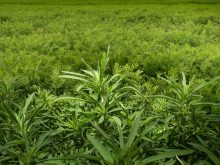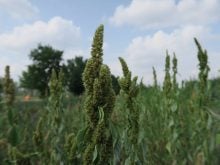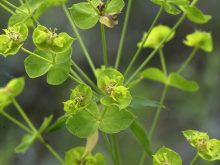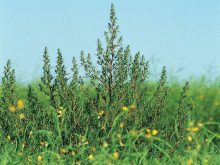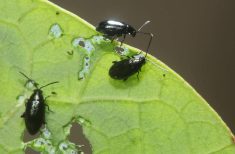MOOSE JAW, Sask. — Controlling weeds in oats has always been a problem, but researchers are looking at integrated management strategies that could help.
Eric Johnson of the University of Saskatchewan’s plant sciences department said wild oats, the second most abundant weed on the Prairies, is a major problem because it can’t be selectively removed from cropped oats with a herbicide.
A herbicide screening project for a couple of years resulted in “dead, dead, dead” oats, he told the Prairie Oat Growers Association annual meeting.
Read Also

Growing garlic by the thousands in Manitoba
Grower holds a planting party day every fall as a crowd gathers to help put 28,000 plants, and sometimes more, into theground
Kochia is also becoming a concern. It is the 10th most abundant weed but is becoming resistant to Group 2 herbicides and glyphosate.
“In the U.S., it’s also developing resistance to Group 4s,” Johnson said.
Glyphosate resistant kochia is worst along the South Saskatchewan River in the Leader and Lancer areas of Saskatchewan.
“The big problem down here is that it’s dominated by chem fallow,” Johnson said. “
We really have to rethink chem fallow.”
He said growers are trying tank mixing, which is one solution.
However, in Australia, where glyphosate resistance is a bigger problem, much of the resistance developed on bare land without competition, he said.
Johnson said adding another herbicide to a tank mix means growers are really only spraying one herbicide and increasing selection pressure.
“We might even have to go back to some tillage if you’re going to fallow.”
He said the real solution is integrated weed management, or “many little hammers” to gain control.
Some of the U of S research is looking at a long-term rotation study based on work done at Lacombe, Alta., in barley.
There, researcher Neil Harker looked at wild oat management in a continuous barley or canola-barley rotation and also at other factors such as cultivars, seeding rates and row spacing.
He found that wild oats could be controlled in barley with fairly low herbicide use if other practices were followed.
The U of S oat study is in its third year and uses rotations of continuous oats, oats-canola-oats-peas and oats-canola-barley-peas at Saskatoon and Indian Head.
Johnson said rotation effects won’t be known for five years, and researchers hope the study will run for 10 years.
They have found that narrower row spacing of eight inches produced better results than row spaces of twice that.
Conversely, wider row spacing resulted in yield decreases of 11 percent in Saskatoon and 10 percent in Indian Head, Sask.
“It’s interesting because the trend in equipment is to go the opposite way,” he said.
“I understand that. I don’t think you change what you’re doing based on a little bit of weed control.”
In Australia, herbicide resistance drives the entire cropping system, and Johnson said Canadian growers fortunately aren’t at that point. Australian growers are moving back to narrower row spacing and using disc openers.
Oat yields in the presence of wild oats increased seven percent in Saskatoon and 10 percent in Indian Head when the seeding rate was doubled from 200 to 400 seeds per sq. metre.
As well, the narrower row spacing reduced wild oat seed production by 30 percent in Saskatoon and 82 percent in Indian Head.
The doubled seeding rate resulted in 51 percent less wild oats seed production in Saskatoon and 20 percent less in Indian Head.
The results indicate promise for wild oat control, but Johnson said researchers also recognize that sometimes growers need a big hammer.
An experiment that used the label rate and a doubled rate of several herbicides from several groups found three herbicides that have promise for kochia control:
- Cadet, a Group 14 soybean herbicide, was effective on kochia but not many other weeds, he said. It isn’t available in Western Canada.
- Benchmark, which is no longer available but that contained a Group 2 and Group 6 combination, worked well despite Group 2 resistance.
- Infinity, a Group 27 and Group 6 product that is not registered in oats, also performed well.
“We will talk to Bayer and the provincial minor use co-coordinator about perhaps getting Infinity registered in oats,” Johnson said.
“Oats isn’t a minor crop, but we can make the argument that kochia is not a widespread pest so it’s a minor pest in a major crop.”






